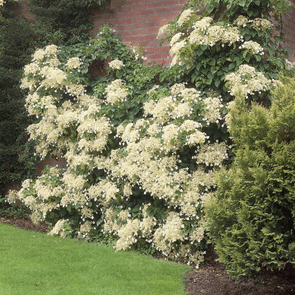Discover expert advice about choosing and growing clematis vines, including varieties, care, and pruning tips.

The Essential Guide to Growing Clematis Vines

On This Page
Clematis Benefits

Whether reaching for the sky or blanketing the ground in blossoms, clematis add romance wherever they are planted. Plants may offer velvety flowers varying from 1 inch wide to 10, evergreen or deciduous foliage, and compact or sprawling habits.
By growing vertically, they allow gardeners to expand the flower power in their yards in a modest ground footprint. Here’s how to select and care for these easy-growing flowering vines and shrubs in your garden.
Clematis Vine Care and Growing Tips

- Common name: Clematis
- Botanical name: Clematis species and hybrids
- Zones: 4a to 9b
- Pollinators: Many attract bees and butterflies, C. virginiana also supports some beneficial wasps and moths.
Clematis Species to Grow
One of the most popular flowering vines in our gardens, there are over three hundred species of clematis that are native to every continent except Antarctica, says Stacey Hirvela, marketing manager/horticulturist for Proven Winners ColorChoice Shrubs, yet only a handful of species make up the ones we find in garden centers.
These break into two main types, she says: woody deciduous vines and low-growing herbaceous perennials that cannot twine or climb. Brittle twiggy stems carry a canopy of narrow pointed leaves that twine on narrow supports before forming flowers that may be flat, upright or nodding, star- or palm-shaped, single or double.
Among the woody vines, there are a few evergreen and semi-evergreen varieties. If you’re looking for winter coverage, seek out one of these.
Notable Varieties

Some recommended new clematis vines worth seeking out include:
- ‘Diamond Ball,’ a stunner delivering elegant double white flowers with lime highlights over several months grows 6 feet high.
- Stand by Me,’ a bush-type clematis with near-navy blue pendant trumpets from spring through summer, averaging 3 feet tall.
- ‘Sweet Summer Love,’ a new armandii hybrid with the same vanilla fragrance, but instead of white flowers, they begin red and turn bright purple – while blooming a month earlier.
When Does Clematis Bloom?

By selecting varieties with varied bloom times, you can enjoy clematis flowers from spring through autumn. Rambling types like evergreen Clematis montana with leathery leaves and fragrant C. armandii (sweet autumn clematis) that easily reach 20 feet long are great for privacy screens.
On the flip side, compact herbaceous types topping out at 2 feet x 2 feet can star in the front of the border. Most deciduous clematis, like iconic C. ‘Jackmanii’ with its large purple flowers, grow to 8 feet high on average, making them perfect adornments for arbors, tuteurs or obelisks, and mailboxes.
After blooming, many seedheads feature tufted, fluffy plumes that look like gossamer.
Can You Grow Clematis in Containers?
Growing on a deck or patio? Try growing smaller clematis in containers. Georgia Clay, plant selections manager for Monrovia, says, “Compact varieties like those found in the Boulevard series are some of our favorites as they only grow to about 5 feet and won’t outgrow a large container or small area of the garden.”
Where to Plant Clematis

“The biggest key to success with clematis is good drainage,” says Stacey. The roots are sensitive to root rot. “Other than that, there’s an old adage for planting clematis that would serve any gardener well: feet in the shade, head in the sun. The roots need to be kept cool and shaded, which can be done with mulch and/or by planting a large-leafed perennial or shrub near the base to provide coverage, whereas the vines/top growth need to be in the sun.”
In hotter conditions, a partial-shade site protected from afternoon sun is best. Georgia recommends rich amended soil.
Deciduous vines are lighter than a wisteria or rose, so they can grow on a mailbox or obelisk, she says. They do need fine texture to twine around, like wire mesh, a bamboo stake or another plant. Large evergreen vines will need a strong arbor. For the low herbaceous types, a peony ring helps display them perfectly.
Pruning Clematis
Many gardeners are unsure how to prune their clematis for the best flowering. “A well-pruned clematis will flower from top to bottom for that lovely curtain-of-blooms effect,” Stacey says. “Unpruned clematis will bloom only at the tips, making it difficult to enjoy the flowers.”
There are three groups with different pruning recommendations. You can tell which you have by its bloom time.
Here’s how to identify and prune each group:
- Group 1: blooms early on old wood (last year’s growth). Plants can be pruned after they flower in winter or spring.
- Group 2: blooms on old wood in early summer and continues to bloom on new wood through summer. Prune back to roughly 2 feet or so above the ground in early spring.
- Group 3: blooms on new wood later in summer. It can be pruned hard, usually to just two to four buds above the ground.
Clematis Not Blooming
If your plant isn’t blooming, you may have pruned it at the wrong time. To fix this, Stacey says, “The best approach in this situation is to treat it like a group 2 and cut back by about half to two-thirds in early spring. This will leave some old wood as well as encourage new growth so you can observe what happens from spring through mid-late summer and determine when the flowers begin to appear.”
Sources
- Proven Winners
- Monrovia
- White Flower Farm
About the Experts
A graduate of the New York Botanical Garden School of Professional Horticulture, Stacey Hirvela is a marketing manager/horticulturist for Proven Winners ColorChoice Shrubs. Stacey previously worked as a garden editor at Martha Stewart Living magazine.
Georgia Clay has worked for five years as the plant selections manager for Monrovia. She studied horticulture at Oregon State University.



